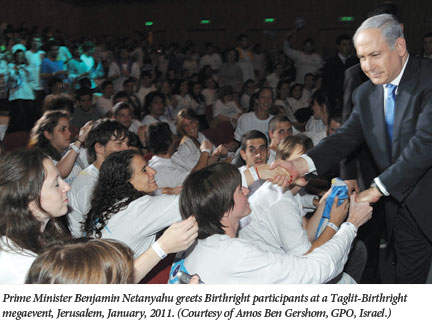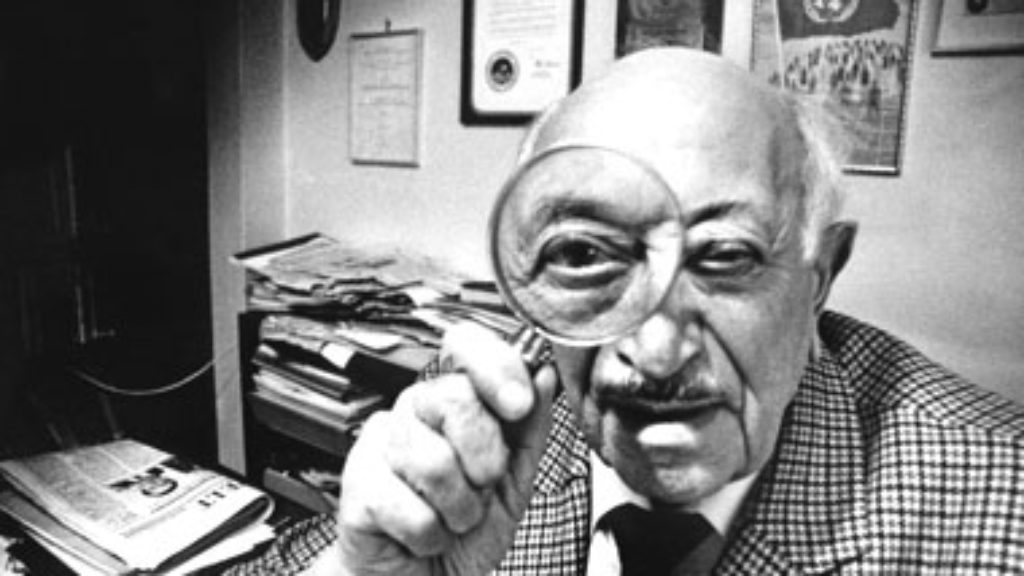The Birthright Challenge
This fall, more than ten thousand American Jewish college students are returning to their campuses after enjoying an all-expenses-paid trip to Israel. For ten days, they traversed the country by bus, visited its holy sites, and hiked its mountains, all while being put up in hotels with bountiful buffet dinners. They were only the most recent beneficiaries of Birthright Israel, the $600-million philanthropic initiative that has treated more than 260,000 diaspora Jews between the ages of 18 and 26 to educational tours of Israel since 1999.
In a little over a decade, Birthright Israel (referred to in Hebrew as “Taglit,” meaning discovery) has become one of the most well known Jewish organizations, and its trips a rite of passage for members of the tribe. Yet a widespread misconception—that Birthright’s main purpose is to encourage participants to make aliyah (move to Israel), or at least become Zionist activists—persists, even in the minds of many alumni. My own Birthright experience led me to make the same mistake when, on the third night of the trip, my forty-person tour group joined several thousands of our peers for what Birthright aptly calls its “megaevent.” A spectacular hybrid between a political rally and a dance party, the megaevent brings together scores of Birthright groups for an evening of welcome, thanks, and grinding to Israeli hip hop. In our case, the emcees of the evening were a knockout immigrant couple (he from Brooklyn, she from Kiev), and the keynote speaker Israeli Prime Minister Ariel Sharon. Towards the end of his impassioned “Welcome Home” address, the Prime Minister encouraged all of us to follow in the couple’s footsteps by finding a spouse on the dance floor—and making aliyah. But it was all a bit misleading.
While the Prime Minister’s message was a classically Zionist negation of Jewish life in the diaspora, it is precisely diaspora Jewish life that Birthright exists to boost. As sociologist Shaul Kelner writes in his prize-winning Tours That Bind: Diaspora, Pilgrimage, and Israeli Birthright Tourism, Birthright is a “diaspora-building enterprise” whose “raison d’être is to ensure the continued existence of vibrant, Israel-oriented Jewish communities abroad.”
Initiated in the mid-1990s by Seagram Company chairman Charles Bronfman and hedge fund manager Michael Steinhardt, Birthright was a direct response to the disheartening revelations of the 1990 National Jewish Population Survey (NJPS): rapidly increasing rates of intermarriage, decreasing rates of Jewish community involvement, and weakening attachment to the State of Israel. Since research showed the extraordinary impact educational tours of Israel can have on the Jewish identity of young people, Bronfman and Steinhardt decided to make the experience much more widely available. But, as Kelner makes clear, the idea has never been to persuade participants to immigrate:
The ticket that Birthright Israel provides is round-trip, not one-way. In this sense, although it is involved in bringing Jews to Israel, it is also very much in the business of flying them back out . . . The exhortations to make aliyah voiced by cabinet ministers at Taglit megaevents must be understood against this backdrop.
When I think back to the hikes, the discussions over dinner, and of course, the many hours on the bus, I realize that not a single Birthright staff member echoed the Prime Minister’s philo-migratory message. Rather, they stuck closely to the organization’s mission statement: “to diminish the growing division between Israel and Jewish communities . . . and to strengthen participants’ personal Jewish identity and connection to the Jewish people.”
Tours that Bind is only one example of the growing corpus of literature about Birthright. In the past three years, four books have been published on the topic, and since 2000, Brandeis University’s Cohen Center for Modern Jewish Studies (CMJS), under the direction of Leonard Saxe, has produced regular evaluation reports that measure the impact the trips have had on participants. The first of these reports, published in August 2000, was based on information gathered by participant observers who accompanied the first trips in Winter 1999, and then conducted follow-up interviews with participants. Their conclusion: “this experiment in nurturing individual and collective Jewish identity has had very positive effects, at least in the short run . . . Whether the experience has long-term impact in shaping the Jewish engagement of young people is a question for future research.” Subsequent CMJS reports have been, on the whole, similarly upbeat.

This optimism also characterizes much of Saxe’s own writing about Birthright, including his 2009 book Ten Days of Birthright Israel: A Journey in Young Adult Identity, co-authored with Barry Chazan, the architect of Birthright’s educational curriculum. The two provide an informative insiders’ account of how Birthright has become an agency that works with 30 different organizations to design and administer trips tailored to different types of young Jews (religious, secular, LGBT, environmentalist, etc.) from 56 countries. But as Saxe and Chazan are the first to acknowledge, this account is not without bias. “To be sure,” they write, “our objectivity has been affected, possibly even compromised by our involvement in the program design. But the central reason that this account is so positive is that we have been able to . . . watch thousands of young Jews take their journey through the Birthright Israel curriculum.”
Shaul Kelner, as it happens, led a team of those first participant observers in 1999, and continued to research Birthright under the auspices of CMJS until 2004. Although a careful student of both Chazan and Saxe, he finds himself unable to share their euphoria. “After having spent the first years of this study trying to understand how diaspora homeland tourism succeeds in accomplishing its sponsors’ goals,” he writes in the book’s preface, “I spent the latter years trying to understand how it fails to accomplish them.” Drawing upon the sociological sub-field of “tourism studies,” Kelner takes us on a tour of tours, beginning each chapter, save the concluding one, with a depiction of a Birthright moment—a hike up Masada, a night in a Bedouin tent, a visit to the Western Wall—and uses it as a springboard to explain which aspects of tourism are at play.
His discussion of the mifgash (shared encounter with Israeli peers), for instance, goes beyond that of his predecessors and challenges their conclusions. Most Birthright groups are joined for several days by a troop of IDF soldiers who are often dressed in civilian clothes. This encounter, or mifgash, “has become known as ‘the jewel in the crown’ of the Birthright Israel trip,” according to Saxe and Chazan, and “the most striking way possible to exemplify Israel’s diversity.” Kelner’s view of the mifgash is more skeptical. He observes that it is rarely a pluralist moment because trip organizers “often select and prepare” participants “who will voluntarily reinforce the program’s core messages.” Kelner may be even more right about this than he realizes, particularly with regard to Birthright’s commitment to the diaspora. Sometime during the two days I spent talking with Yaeli, the soldier I befriended on the trip, she frankly expressed her own desire to live outside of Israel.
The open secret about the mifgash is that it creates a highly sexualized and flirtatious atmosphere, an element completely, perhaps deliberately, ignored in Saxe and Chazan’s book. Kelner, by contrast, emphasizes the way in which this atmosphere favors interaction between female tourists and Israeli male soldiers. There is “a mutuality of objectification,” he explains, “as male Israeli soldiers and American women fantasize each other as embodiments of macho sensuality, on the one hand, and feminine aggressiveness and promiscuity, on the other.” Why no such mutuality of objectification underlies how female soldiers relate to the American male tourists, Kelner doesn’t attempt to answer, but it certainly is not because the American men fail to fantasize. If there is something to Kelner’s claim that the sexual interaction is “rooted in fantasies of eroticized exotic Others,” then perhaps we can see why a sensitive American male, for example, might be a non-eroticized other. While sensitivity may be an attractive quality to women seeking a committed relationship, the ephemeral nature of a five-day encounter with foreign tourists is not likely to encourage the female soldiers to think of the American visitors in these terms. Kelner may be overstating the whole phenomenon, but it doesn’t change the fact that these rules of attraction, while intensifying the experience for some, mean that young, Reform Jewish men—the demographic statistically most ambivalent about Jewishness—tend to get less out of the mifgash than do their female counterparts.
Kelner devotes most of his attention to the way in which the Birthright tourist encounters Israel “as a theater of thematically coherent signifiers.” Birthright, explains Kelner, employs the tools and symbols of the tourism trade—themed environments that display a specific lifestyle or period, guides who frame the narrative of the trip, souvenirs that represent the local style—in a way that encourages participants to ascribe meaning to the place, and to connect that meaning to their lives back home. And it is specifically the “semiotics of difference,” the signs that drive home to Birthrighters the distinction between the Jewish homeland and its diaspora, that prompts the young tourists to ponder the nature of their Jewish identity outside Israel.
Unfortunately, Kelner has brought along not only the insights of his field, but the academic jargon and the hyper-explanatory prose that come with it. Take, for example, this qualification:
From a retrospective vantage point, the tour cannot logically be said to have changed a life, considering that none of the alternative possible futures were ever lived out. Looking backward, we can speak of diaspora homeland tours as life changing only in a narrative sense, to the extent that former tourists position the trips as turning points in their stories of self.
Kelner’s point here is not about diaspora homeland tours at all. It is as true about Birthright as it is about the prom or the SAT or the French Revolution.
Statements like this read as patronizing when juxtaposed with the long, verbatim block quotations from participants—studded with “like”s and “totally”s—that appear throughout the book. Though it’s clear that Kelner, like Saxe and Chazan, has developed a genuine affection for his subjects, this doesn’t prevent them from coming across, on the whole, as naïve, impressionable, and callow.
Sarah Glidden is one Birthright alumna who belies such characterizations. Her autobiographical graphic novel How to Understand Israel in 60 Days or Less tells the story of a left-of-center American Jew with a “‘goy’ boyfriend” (Glidden’s words) named Jamil who spends her 2007 trip thinking deeply and honestly about everything she sees, from the Western Wall to the separation barrier. Of the Bedouin village visited by almost every Birthright group, she says, “it’s as if a piece of Epcot center broke apart from the mainland and somehow came to rest in the middle of the Negev.” It is a keen observation, and one that complements Kelner’s less vivid reflection that “although the Disneyland metaphor is not a perfect one, it helps reveal the fundamental nature of the tourist engagement with Israel, which ultimately is built around the consumption of themed environments.” Glidden’s book can be read as a smart, whimsical companion to Kelner’s.
Perhaps the most delightful aspect of the book is the sincerity with which Glidden reflects not only on the sites she sees and the emotions she feels. At various points, she lets us in on the ongoing trial she is staging in her head about whether or not Birthright is trying to brainwash her. Walking around the city of Holon, she realizes, “The feeling of foreignness, the sticking-out-like-a-sore-thumbness that I normally have while travelling. Somehow I don’t feel it here.”
It is emotional moments like this one that Kelner has set out to investigate. Referring to a female participant’s statement that in Israel “everything seems to have meaning,” he comments, “Marx would call this fetishism.” Whether he needs Marx to make the point or not, Kelner is right to note that Birthright treats its participants as consumers:
Israel experience travel encourages the construction of diasporic Jewish identities as consumer identities to be realized through the consumption of symbols, products, and experiences that are commodified in an Israeli market. The tours create an environment for expressing and developing an identification with the Jewish homeland and with Jewish culture through consumer acts like purchasing souvenirs, eating foods, viewing films, visiting museums, shooting photographs, and so on.

This helps to explain the gap between the extraordinary impact the trips have had on the attitudes of participants on the one hand, and the underwhelming influence they have had on their day-to-day behavior on the other. In Kelner’s words, “the trips generally have not met with unbridled success in translating the enthusiasm they generate into sustained, broad-based participation in Jewish religious, organizational, and political organizations.” Why not? Because “the tours primarily engage people in—and hence prepare people for—a narrow Jewish behavioral paradigm centered on consumption.”
Despite Kelner’s attempt to soften this conclusion, prefacing it as he does by saying that he is “doubly wary of offering a post hoc explanation of a non-finding,” I would take it a step further. Treating Birthright participants as consumers has its limitations, but they aren’t really ordinary consumers, because they haven’t paid for the trip. If Birthright exists to persuade the next generation of Jews to take responsibility for the future of Jewish diaspora life, telling them that an all-expenses-paid trip is their, well, birthright, may have unintended consequences.
Nonetheless, Birthright has been an incredible success. The CMJS report published in February of this year (which excludes Orthodox respondents) showed that participants are 51 percent more likely than non-participants to marry a Jewish person. When co-founder Michael Steinhardt is introduced to Birthright participants and alumni, he often asks them whether they met their future spouse on the trip-and has also offered free honeymoons to those who have.
However, the report also showed that alumni below the age of 30 are actually less likely to be married than their peers who did not go on the trip. Since participants are more likely than non-participants to want to marry a Jew, they may “spend a longer time searching for a suitable partner and place more value on a non-Jewish partner’s willingness to convert to Judaism,” or so speculates the report. There is probably truth to this, but it raises (or evades) an obvious question: Is finding a nice Jewish boy or girl really so hard? The answer is probably “yes” when participants return to social circles that are not predominantly Jewish. They may find themselves searching for a Jewish spouse without having really made their lives more Jewish, anchored in the Jewish community.
In creating Birthright Israel NEXT, an alumni network whose mission is, in part, “to deepen their personal commitments to Jewish life, and find or form a community where Jewish responsibility, learning, and celebration thrive,” Birthright is trying to address this issue. The organization claims to “have attracted 70,000 young Jewish adults to cultural and educational events and home-based Shabbat meals,” just over a quarter of the number of all Birthright alumni. Kelner’s book, focused specifically as it is on the dynamics of the Birthright tour, says nothing about this initiative, but What We Brought Back, a small new collection of “reflections by alumni,” does.
The volume is eclectic, with essays, poems, plays, photographs, and even a comic strip. There is Ruby Marez, “a Puerto Rican, Panamanian, Polish, Russian, Spanish, African, Lithuanian, Palestinian, Jewish, first-generation American” comedian from St. Louis who returns from Birthright and studies at NEXT’s Jewish Enrichment Center in Manhattan. We meet M. K. Hall, the Harvard J.D.-turned-creative writer who completes her Jewish conversion classes only after the trip. There is even Jordan Fliegel, who returns to Israel two years after his Birthright trip to play basketball for Hapoel Migdal Jerusalem. It is a charming little anthology that gives testimony to Birthright’s power to enrich and even change individual lives. What it does not and cannot show is whether Birthright will change the trajectory of Jewish life in the diaspora.
Suggested Reading

Patriotism and Its Discontents
While many Jews embraced the Russian revolutionary cause from the very beginning—four of the seven members of the first Bolshevik Politburo were Jews—the revolution did not embrace them for long.

Simon Wiesenthal and the Ethics of History
Was Simon Wiesenthal an intrepid hunter of mass murderers? Or was he in fact more of a charlatan than a hero? Tom Segev's new biography of the most successful—and controversial—Nazi-hunter raises more questions than it cares to answer.

Peace, Plan B
Secretary of State John Kerry's attempt to get Israel and the Palestinians to a final status agreement was never going to work. What will?
In Whose Image?
On the spectrum between animal and divine, where do human beings fall?
Comments
You must log in to comment Log In